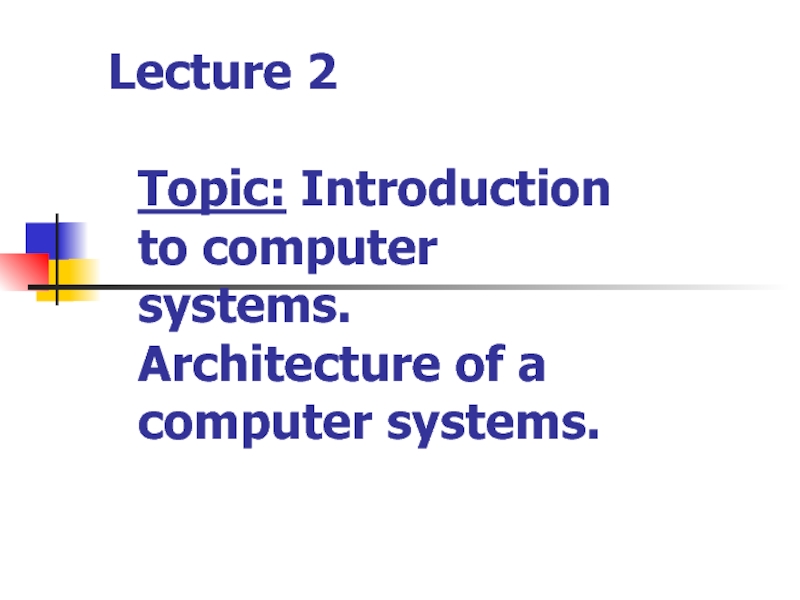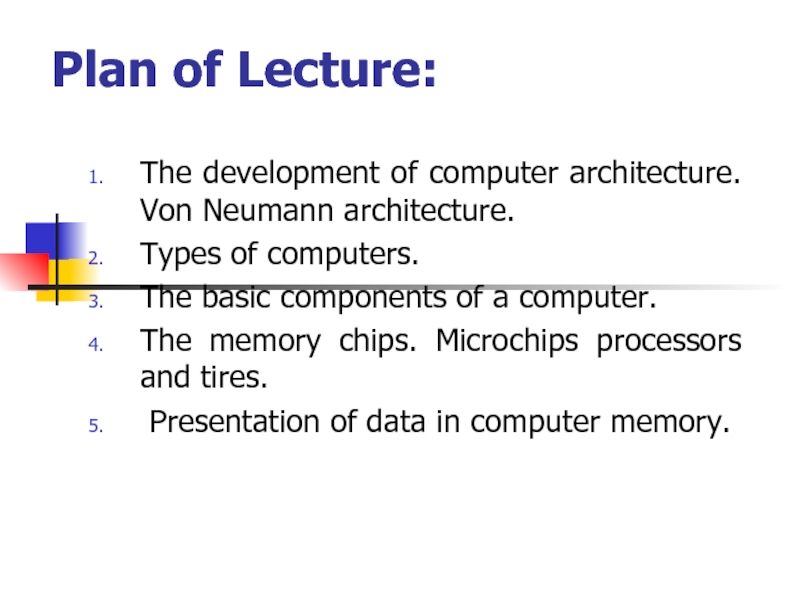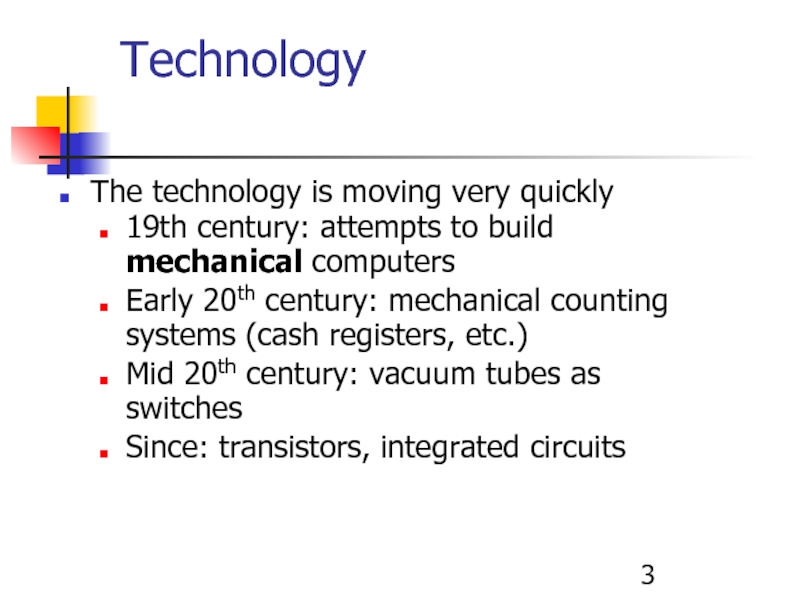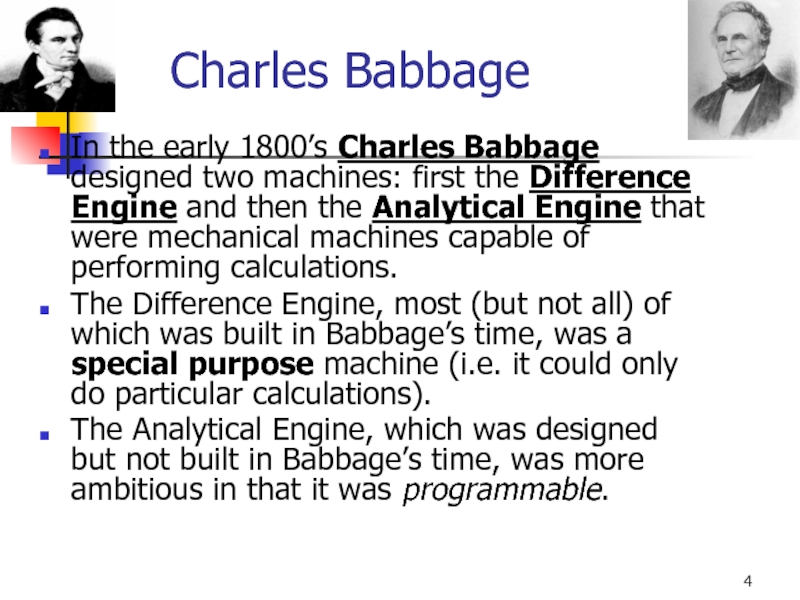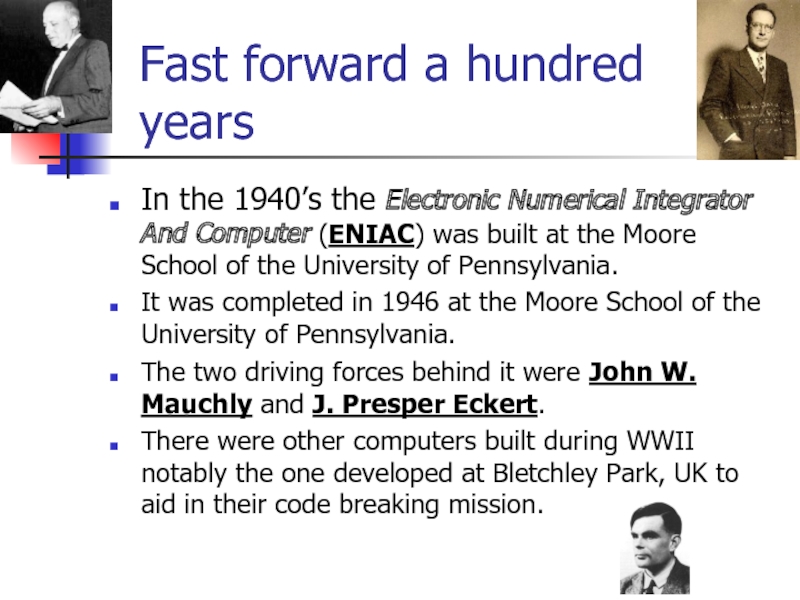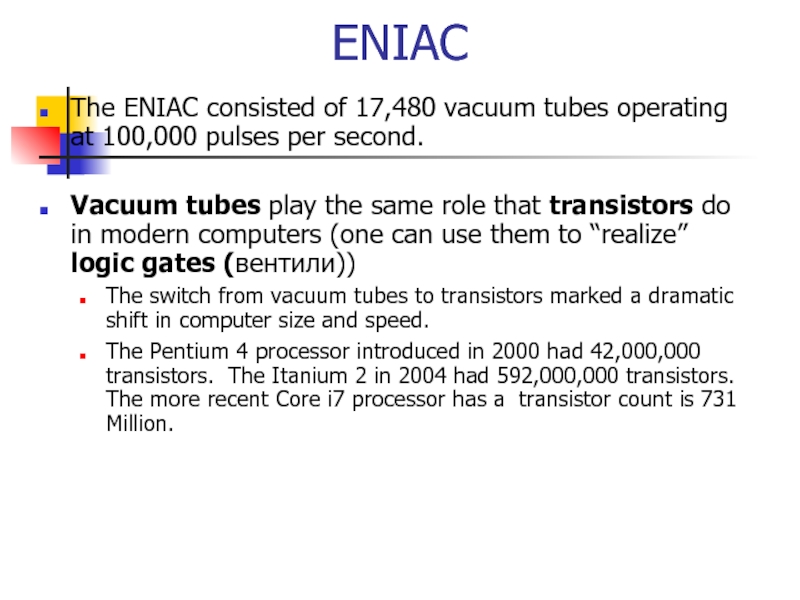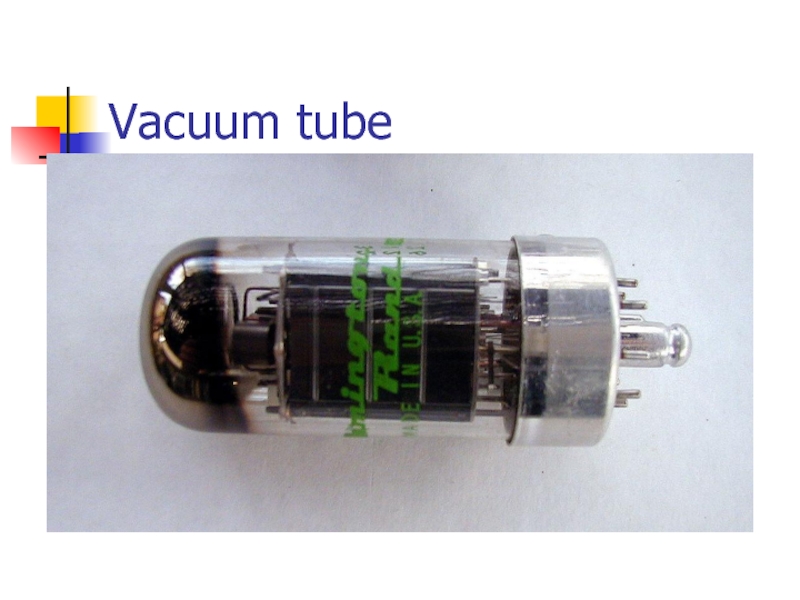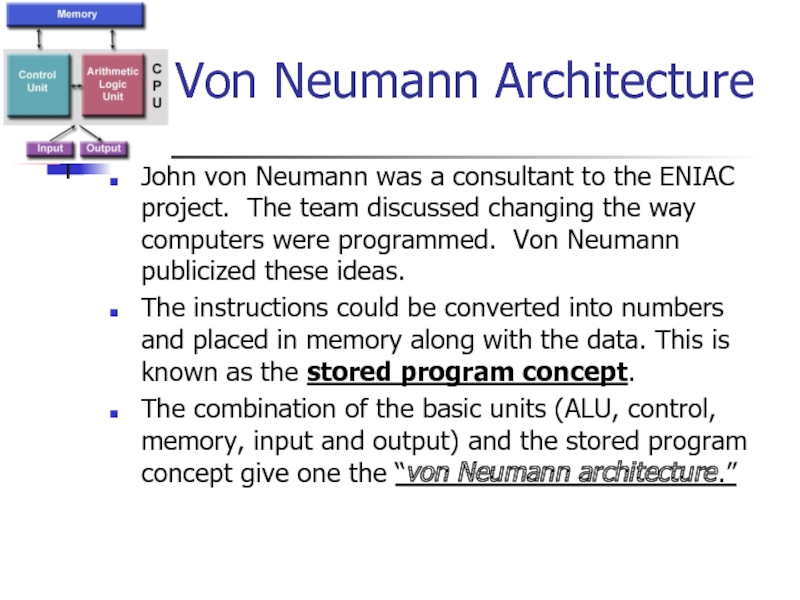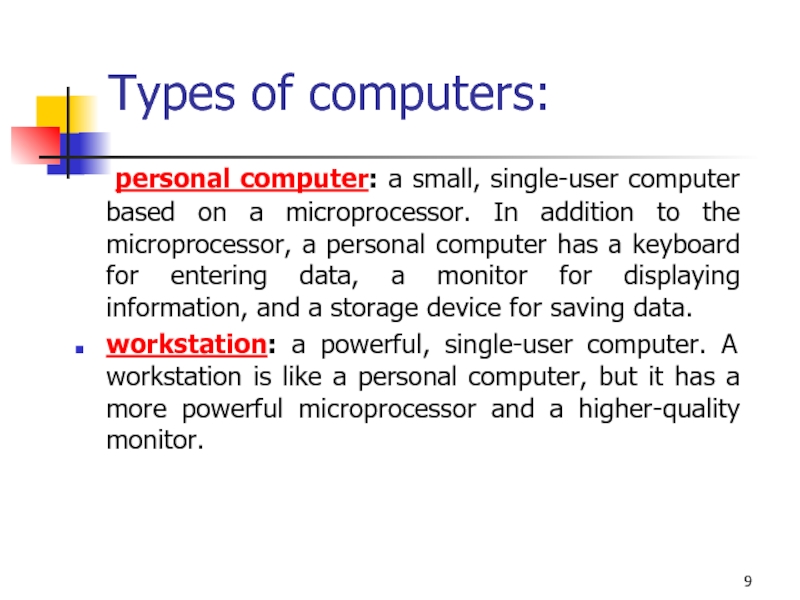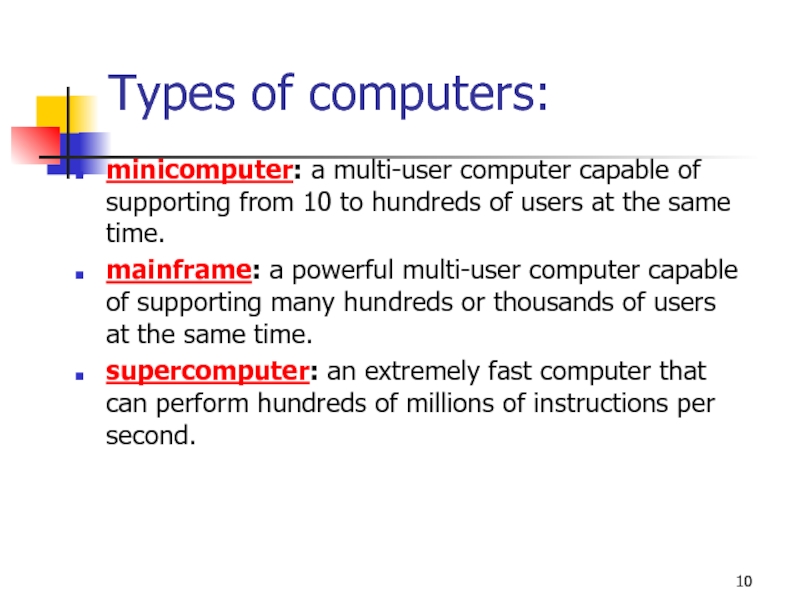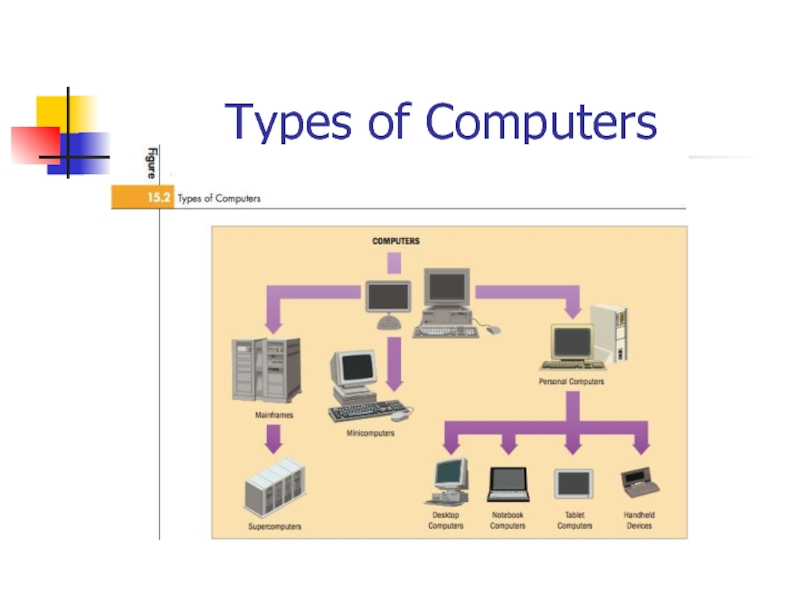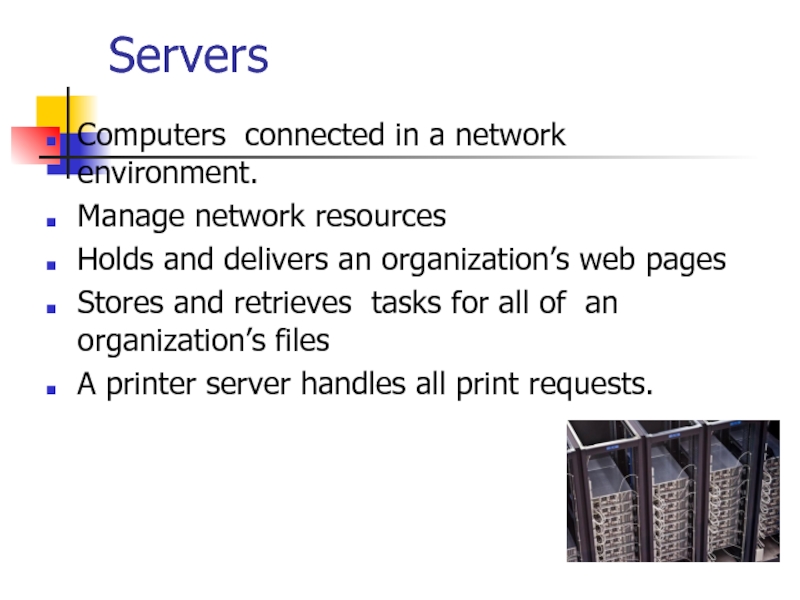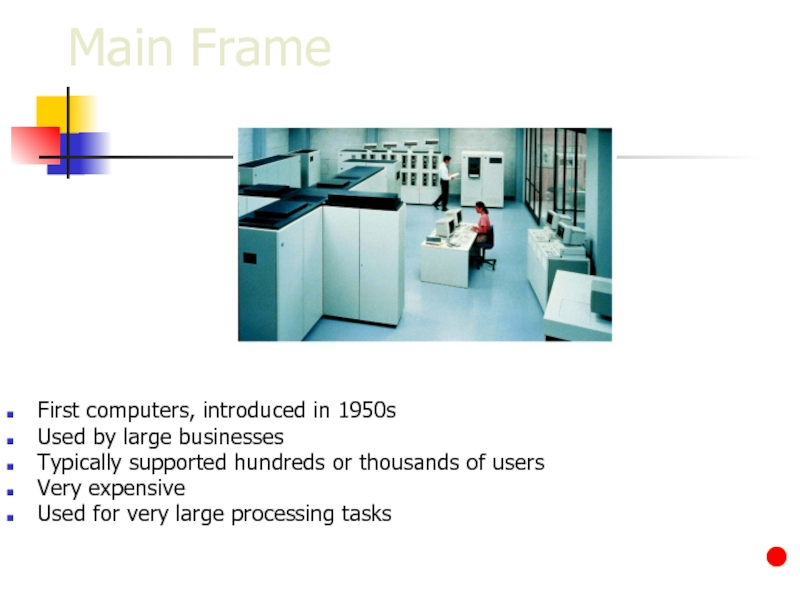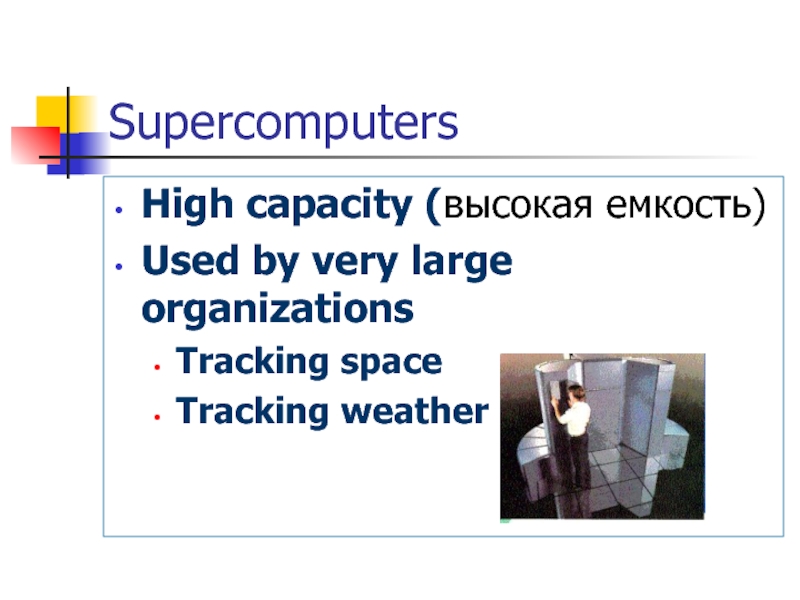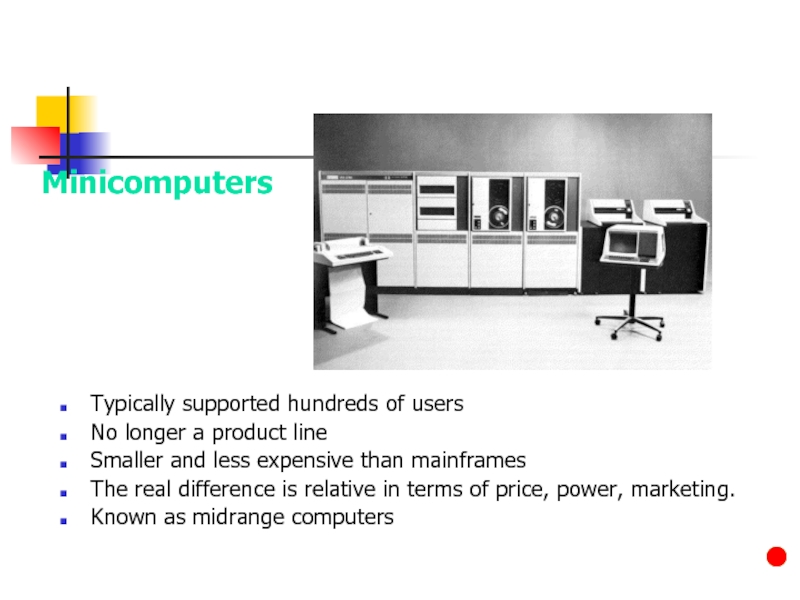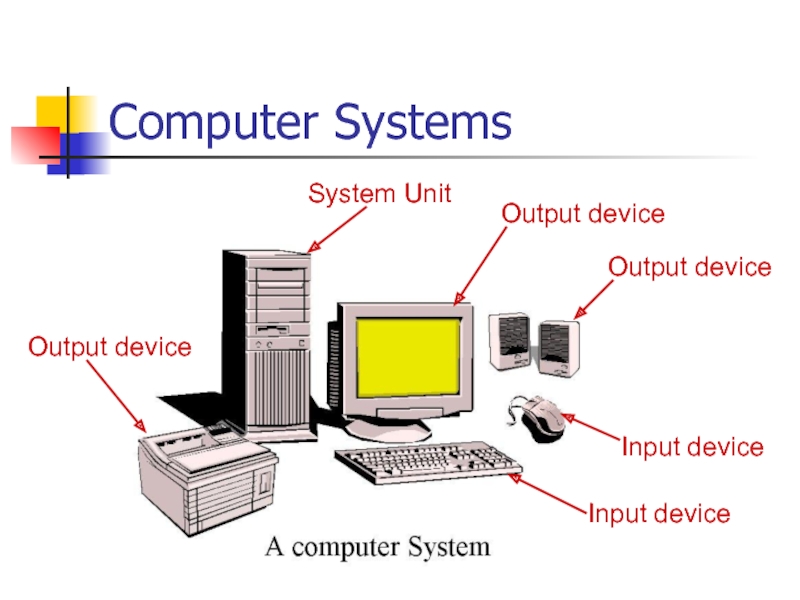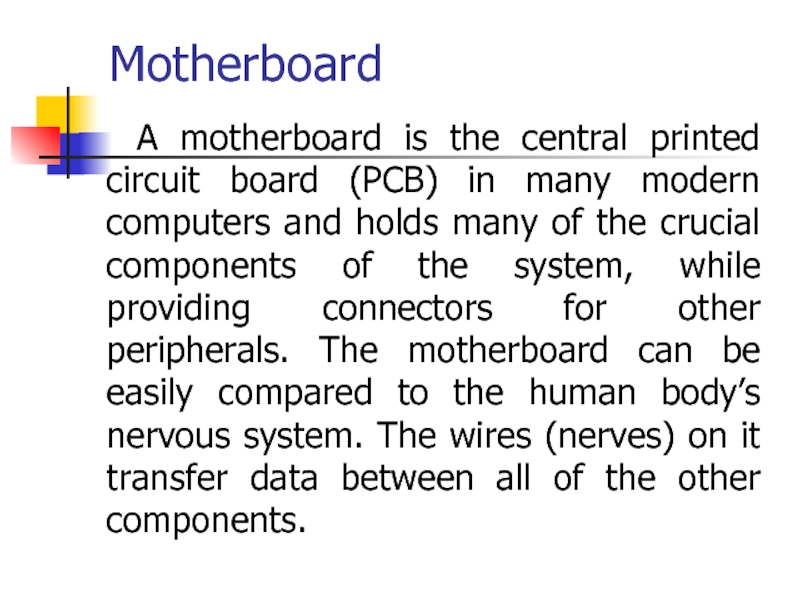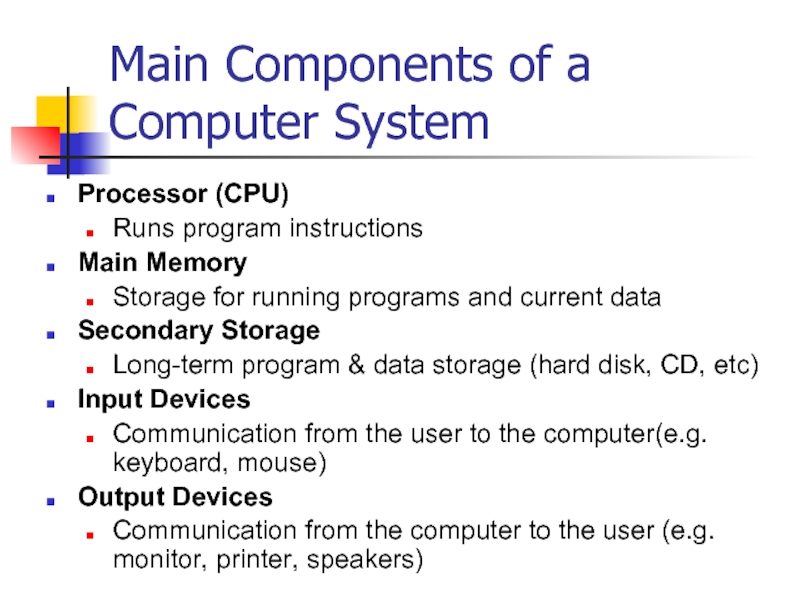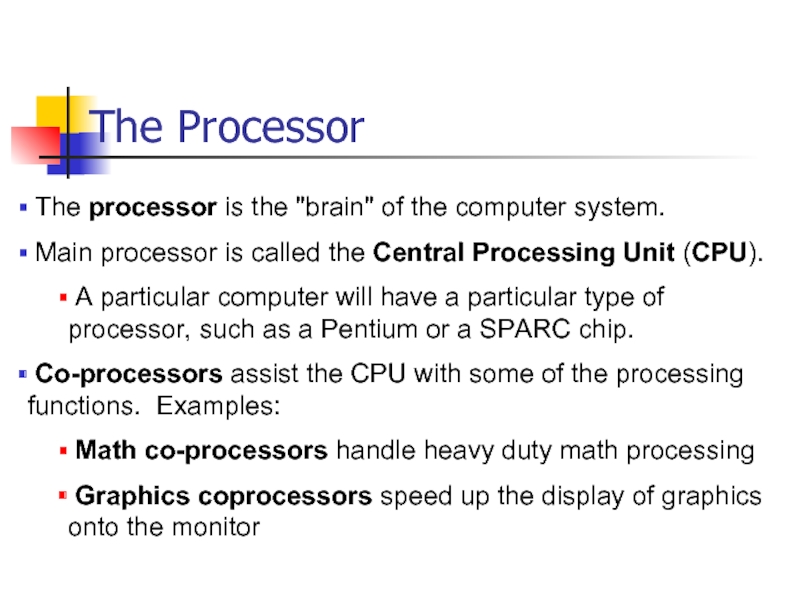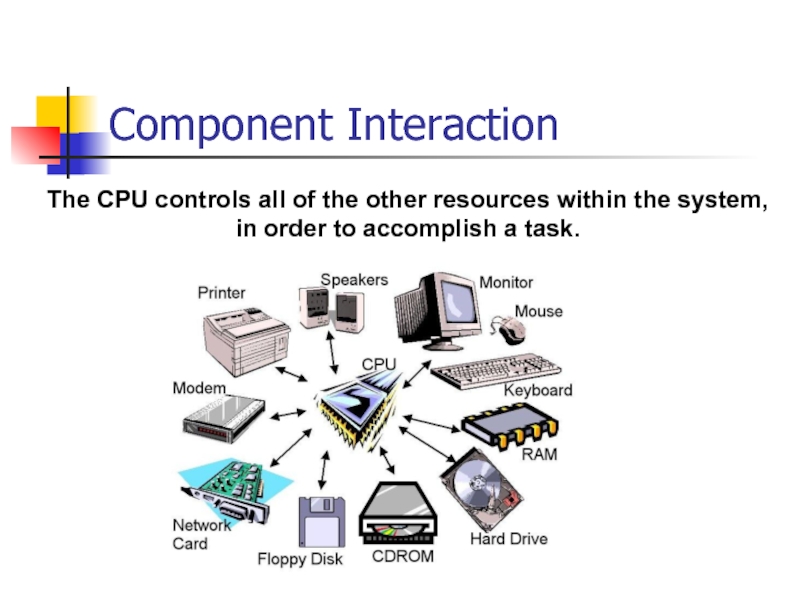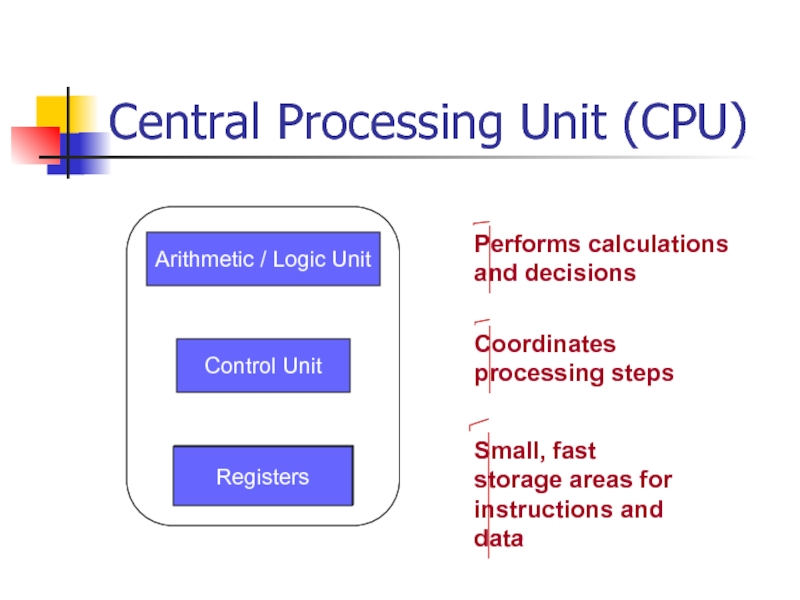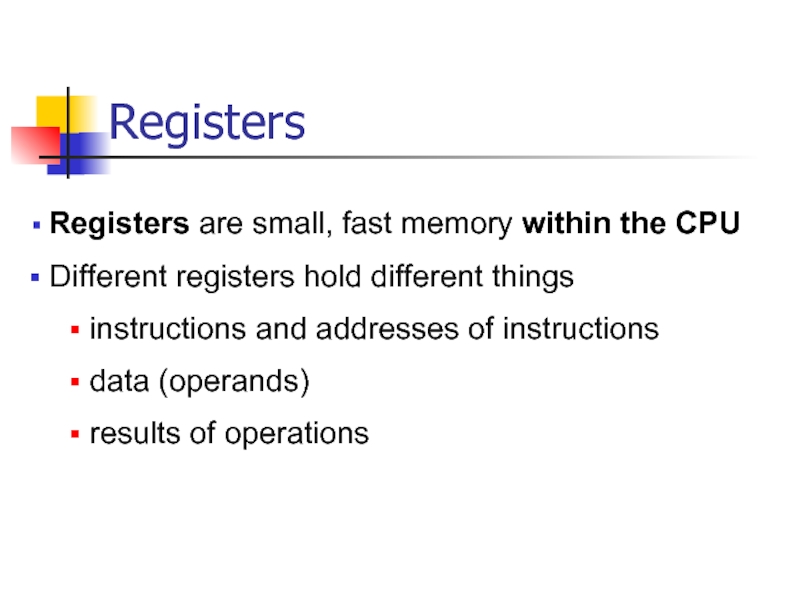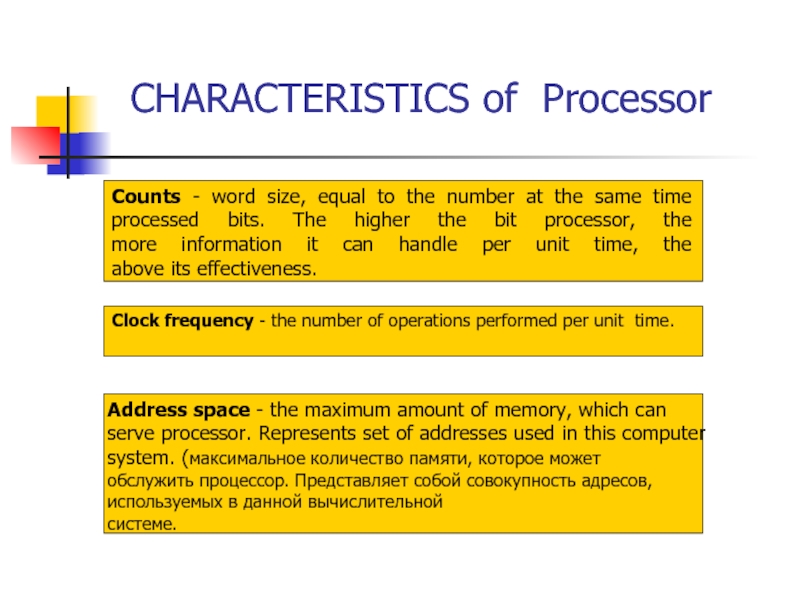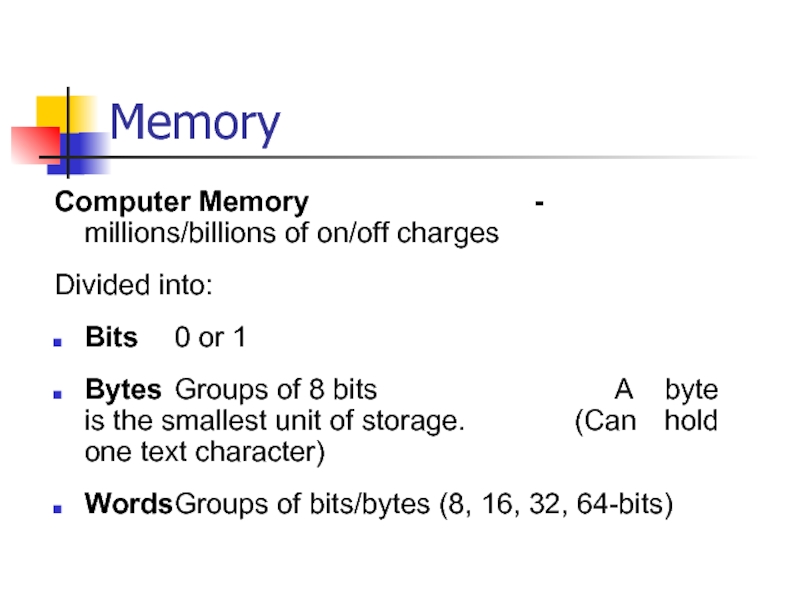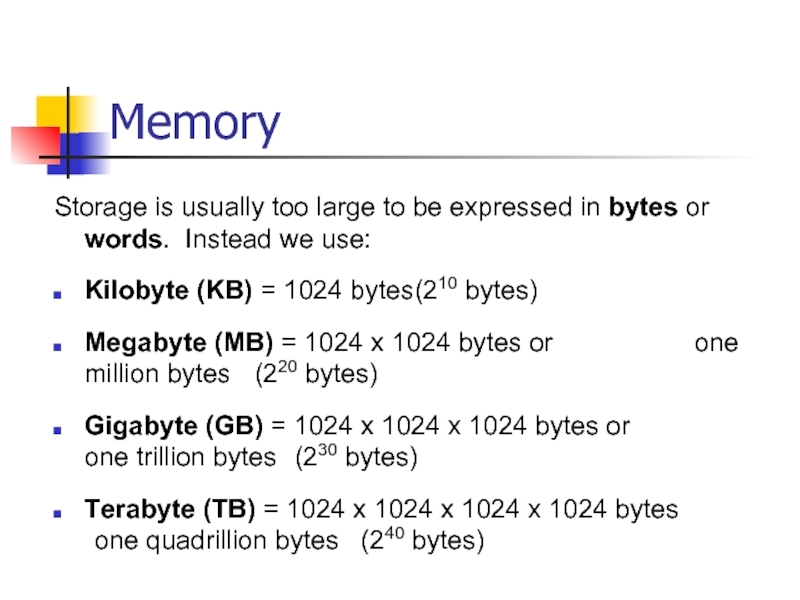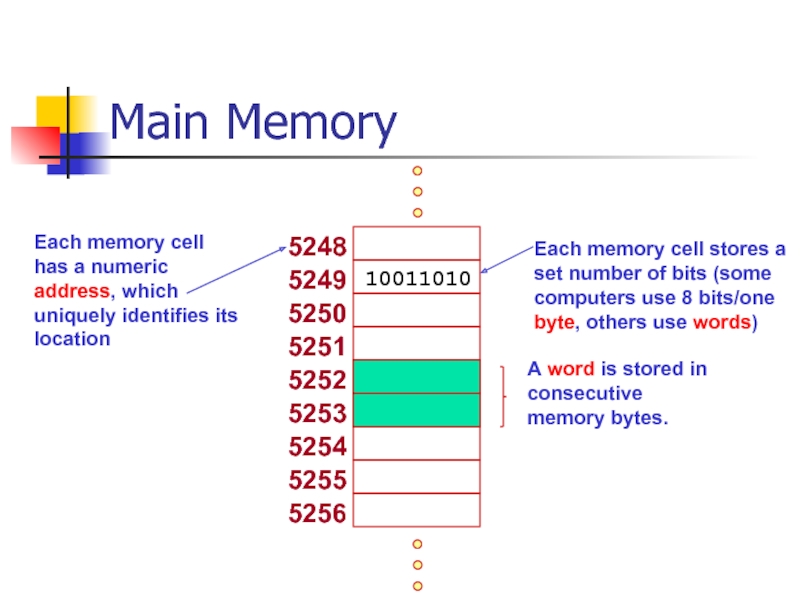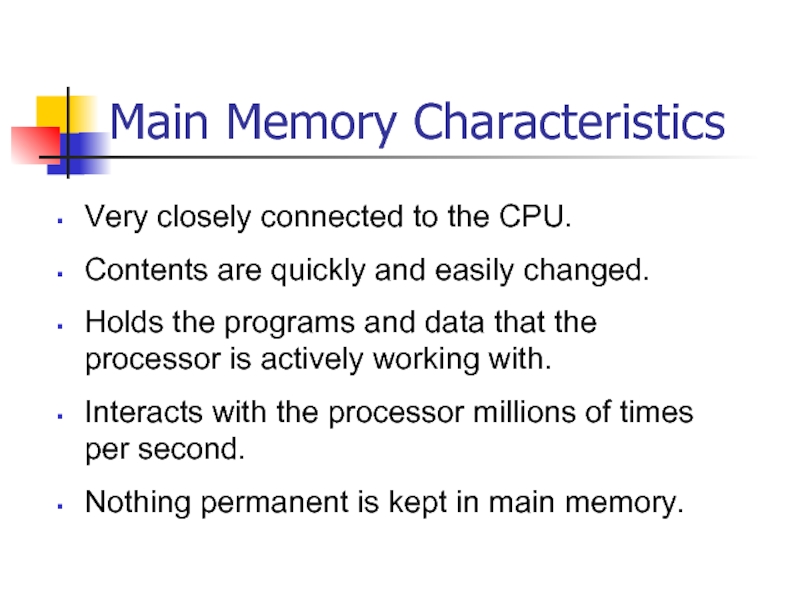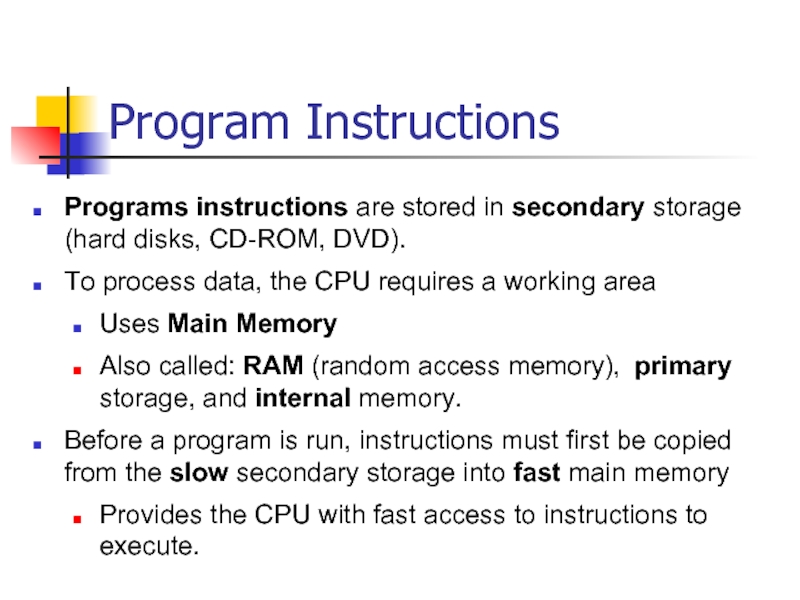- Главная
- Разное
- Дизайн
- Бизнес и предпринимательство
- Аналитика
- Образование
- Развлечения
- Красота и здоровье
- Финансы
- Государство
- Путешествия
- Спорт
- Недвижимость
- Армия
- Графика
- Культурология
- Еда и кулинария
- Лингвистика
- Английский язык
- Астрономия
- Алгебра
- Биология
- География
- Детские презентации
- Информатика
- История
- Литература
- Маркетинг
- Математика
- Медицина
- Менеджмент
- Музыка
- МХК
- Немецкий язык
- ОБЖ
- Обществознание
- Окружающий мир
- Педагогика
- Русский язык
- Технология
- Физика
- Философия
- Химия
- Шаблоны, картинки для презентаций
- Экология
- Экономика
- Юриспруденция
Introduction to computer systems. Architecture of a computer systems презентация
Содержание
- 1. Introduction to computer systems. Architecture of a computer systems
- 2. Plan of Lecture: The development of computer
- 3. Technology The technology is moving very quickly
- 4. Charles Babbage In the early 1800’s Charles
- 5. Fast forward a hundred years In the
- 6. ENIAC The ENIAC consisted of 17,480 vacuum
- 7. Vacuum tube
- 8. Von Neumann Architecture John von Neumann was
- 9. Types of computers: personal computer:
- 10. Types of computers: minicomputer: a multi-user computer
- 11. Types of Computers
- 12. Servers Computers connected in a network environment.
- 13. First computers, introduced in 1950s Used
- 14. Supercomputers High capacity (высокая емкость) Used by
- 15. Typically supported hundreds of users No longer
- 16. Computer Systems
- 18. Main Components of a Computer System Processor
- 19. The Processor The processor is the
- 20. Component Interaction The CPU controls all of
- 21. Central Processing Unit (CPU) Arithmetic / Logic
- 22. Registers Registers are small, fast memory
- 23. CHARACTERISTICS of Processor
- 24. Memory Computer Memory - millions/billions of on/off
- 25. Memory Storage is usually too large to
- 26. Main Memory 5248 5249 5250 5251 5252 5253 5254 5255 5256
- 27. Main Memory Characteristics Very closely connected to
- 28. Program Instructions Programs instructions are stored in
- 29. Instructions An instruction is a sequence of
- 30. Instructions The operation code specifies the operation
- 31. Fetch-Decode-Execute Diagram Program Counter (PC) 3023
- 32. The main device of PC ROM RAM
- 33. System bus The processor sets the address
- 34. The internal memory of the computer
- 35. Cache Memory When an instruction or data
- 36. Decodes the signal received from processor (Декодирует
- 37. TEST Open Internet site Socrative.com Press button
Слайд 2Plan of Lecture:
The development of computer architecture. Von Neumann architecture.
Types
The basic components of a computer.
The memory chips. Microchips processors and tires.
Presentation of data in computer memory.
Слайд 3Technology
The technology is moving very quickly
19th century: attempts to build mechanical
Early 20th century: mechanical counting systems (cash registers, etc.)
Mid 20th century: vacuum tubes as switches
Since: transistors, integrated circuits
Слайд 4Charles Babbage
In the early 1800’s Charles Babbage designed two machines: first
The Difference Engine, most (but not all) of which was built in Babbage’s time, was a special purpose machine (i.e. it could only do particular calculations).
The Analytical Engine, which was designed but not built in Babbage’s time, was more ambitious in that it was programmable.
Слайд 5Fast forward a hundred years
In the 1940’s the Electronic Numerical Integrator
It was completed in 1946 at the Moore School of the University of Pennsylvania.
The two driving forces behind it were John W. Mauchly and J. Presper Eckert.
There were other computers built during WWII notably the one developed at Bletchley Park, UK to aid in their code breaking mission.
Слайд 6ENIAC
The ENIAC consisted of 17,480 vacuum tubes operating at 100,000 pulses
Vacuum tubes play the same role that transistors do in modern computers (one can use them to “realize” logic gates (вентили))
The switch from vacuum tubes to transistors marked a dramatic shift in computer size and speed.
The Pentium 4 processor introduced in 2000 had 42,000,000 transistors. The Itanium 2 in 2004 had 592,000,000 transistors. The more recent Core i7 processor has a transistor count is 731 Million.
Слайд 8Von Neumann Architecture
John von Neumann was a consultant to the ENIAC
The instructions could be converted into numbers and placed in memory along with the data. This is known as the stored program concept.
The combination of the basic units (ALU, control, memory, input and output) and the stored program concept give one the “von Neumann architecture.”
Слайд 9Types of computers:
personal computer: a small, single-user computer based
workstation: a powerful, single-user computer. A workstation is like a personal computer, but it has a more powerful microprocessor and a higher-quality monitor.
Слайд 10Types of computers:
minicomputer: a multi-user computer capable of supporting from 10
mainframe: a powerful multi-user computer capable of supporting many hundreds or thousands of users at the same time.
supercomputer: an extremely fast computer that can perform hundreds of millions of instructions per second.
Слайд 12Servers
Computers connected in a network environment.
Manage network resources
Holds and delivers an
Stores and retrieves tasks for all of an organization’s files
A printer server handles all print requests.
Слайд 13First computers, introduced in 1950s
Used by large businesses
Typically supported
Very expensive
Used for very large processing tasks
Main Frame
Слайд 14Supercomputers
High capacity (высокая емкость)
Used by very large organizations
Tracking space
Tracking weather
Слайд 15Typically supported hundreds of users
No longer a product line
Smaller and
The real difference is relative in terms of price, power, marketing.
Known as midrange computers
Minicomputers
Слайд 17
Motherboard
A motherboard is the central printed circuit board (PCB)
Слайд 18Main Components of a Computer System
Processor (CPU)
Runs program instructions
Main Memory
Storage for
Secondary Storage
Long-term program & data storage (hard disk, CD, etc)
Input Devices
Communication from the user to the computer(e.g. keyboard, mouse)
Output Devices
Communication from the computer to the user (e.g. monitor, printer, speakers)
Слайд 19The Processor
The processor is the "brain" of the computer system.
Main processor is called the Central Processing Unit (CPU).
A particular computer will have a particular type of processor, such as a Pentium or a SPARC chip.
Co-processors assist the CPU with some of the processing functions. Examples:
Math co-processors handle heavy duty math processing
Graphics coprocessors speed up the display of graphics onto the monitor
Слайд 20Component Interaction
The CPU controls all of the other resources within the
in order to accomplish a task.
Слайд 21Central Processing Unit (CPU)
Arithmetic / Logic Unit
Registers
Control Unit
Small, fast storage areas
Performs calculations and decisions
Coordinates processing steps
Слайд 22Registers
Registers are small, fast memory within the CPU
Different registers
instructions and addresses of instructions
data (operands)
results of operations
Слайд 23CHARACTERISTICS of Processor
Counts - word size, equal to the number
Clock frequency - the number of operations performed per unit time.
Address space - the maximum amount of memory, which can
serve processor. Represents set of addresses used in this computer
system. (максимальное количество памяти, которое может
обслужить процессор. Представляет собой совокупность адресов,
используемых в данной вычислительной
системе.
Слайд 24Memory
Computer Memory - millions/billions of on/off charges
Divided into:
Bits 0 or 1
Bytes Groups of
Words Groups of bits/bytes (8, 16, 32, 64-bits)
Слайд 25Memory
Storage is usually too large to be expressed in bytes or
Kilobyte (KB) = 1024 bytes (210 bytes)
Megabyte (MB) = 1024 x 1024 bytes or one million bytes (220 bytes)
Gigabyte (GB) = 1024 x 1024 x 1024 bytes or one trillion bytes (230 bytes)
Terabyte (TB) = 1024 x 1024 x 1024 x 1024 bytes one quadrillion bytes (240 bytes)
Слайд 27Main Memory Characteristics
Very closely connected to the CPU.
Contents are quickly and
Holds the programs and data that the processor is actively working with.
Interacts with the processor millions of times per second.
Nothing permanent is kept in main memory.
Слайд 28Program Instructions
Programs instructions are stored in secondary storage (hard disks, CD-ROM,
To process data, the CPU requires a working area
Uses Main Memory
Also called: RAM (random access memory), primary storage, and internal memory.
Before a program is run, instructions must first be copied from the slow secondary storage into fast main memory
Provides the CPU with fast access to instructions to execute.
Слайд 29Instructions
An instruction is a sequence of bits.
A simple instruction format
Instructions tell the computer’s CPU what to do.
Слайд 30Instructions
The operation code specifies the operation the computer is to carry
The operand/address area can store an operand or an address
An operand is a specific value or a register number
An address allows the instruction to refer to a location in main memory
The CPU runs each instruction in the program, starting with instruction 0, using the fetch-decode-execute (выборки-декодирования-выполнение ) cycle.
Слайд 31Fetch-Decode-Execute Diagram
Program Counter (PC)
3023
Instruction Register
General Purpose
Fetch
Get instruction and increment PC
CPU
33
45
add r3, r1, r2
r1
r2
r3
78
3024
Execute
In this case add r1 and r2 and put result in r3.
Decode
Determine what the instruction is (add)
Then begin again by Fetching the instruction in 3024….
Слайд 32The main device of PC
ROM
RAM
Processor
Data bus
HIGHWAY
control bus
controller
controller
controller
controller
Keyboard
Printer
Display
Drive
Слайд 33System bus
The processor sets the address bus memory address, which wants
On the control bus puts the processor ready signal and the read signal; (На шине управления процессор выставляет сигнал готовности и сигнал чтения);
Noticing the ready signal, check all devices, whether or not on the bus addresses of their address; (Заметив сигнал готовности, все устройства проверяют, не стоит ли на шине адреса их адрес);
RAM, noting that exposed her address, reads the control signal; Memory read address; (Оперативная память, заметив, что выставлен ее адрес, считывает управляющий сигнал. Память читает адрес);
Memory Bus exposes the requested information data; (Память выставляет на шине данных требуемую информацию); The memory puts the control ready signal bus;(Память выставляет на шине управления сигнал готовности);
A processor reads data from the data bus; (Процессор читает данные с шины данных).
Слайд 34The internal memory of the computer
RAM (Random Access Memory)
Located on the
ROM (Read Only Memory)
Used for permanent storage of data that do not require intervention
user (Используется для постоянного хранения данных, не требующих вмешательства
пользователя) (program start and stop the computer, Testing devices,
the control operation of the processor, display, keyboard, printer, external memory)
It is intended for reading information
A cache memory (buffer memory unit)
Internal memory cache located inside the processor
External cache memory located on the motherboard
It used to increase the performance of your computer, matching
operation of devices with different speeds, the exchange of data between
Processor and memory
Слайд 35Cache Memory
When an instruction or data is accessed from main memory,
Слайд 36Decodes the signal received from processor (Декодирует сигнал, поступающий от процессора)
Sends
(Посылает обработанный сигнал для выполнения его устройством)
The resulting signal is converted into a binary form of user-friendly (Полученный двоичный сигнал преобразует в вид понятный пользователю)
Are inserted into the slots (slots) on the motherboard, and to their ports connect additional devices (Вставляются в разъемы (слоты) на материнской плате, а к их портам подключаются дополнительные устройства)
Controllers
Слайд 37TEST
Open Internet site Socrative.com
Press button Student login
Write Room Name YERMAGANBETOVA
Write your
Answer 20 questions
